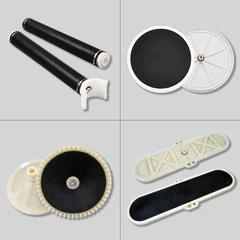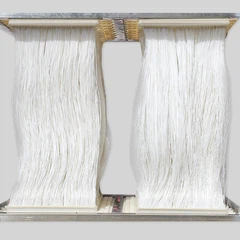Introduction
In the field of sewage treatment, the aeration tank is one of the main treatment units in the biochemical treatment process. Aeration diffusers are installed at the bottom of the tank, which introduce air (oxygen) into the water through the porous membrane on the surface, promoting the decomposition of organic matter in the sewage.
When we properly configure the number of diffusers, we can maintain the stable operation of the biochemical treatment process and ensure that the effluent water quality meets the standards. So, how can we achieve this? This article will introduce in detail how to calculate the number of diffusers needed in an aeration tank, providing guidance for you when designing or updating an aeration tank.
The Significance of Properly Configuring the Number of Aeration-Diffusers
In the sewage treatment system, the configuration of diffusers will affect the operation efficiency and investment cost of the entire treatment system. This is specifically reflected in the following aspects:
1. Promote the Growth of Microorganisms: In the sewage treatment process, microorganisms purify the water quality by decomposing the organic pollutants in the sewage. This process requires an adequate supply of oxygen, which is generally provided by injecting air (oxygen) bubbles into the water through an appropriate number of diffusers.
2. Avoid Resource Waste: Properly configuring the number of diffusers can precisely control the amount of aeration, meeting the treatment requirements while avoiding unnecessary energy consumption. In the activated sludge process, if the dissolved oxygen (DO) in the water is lower than 0.5mg/L, the nitrification reaction in the sewage will be inhibited. When it exceeds 4mg/L, it will cause a waste of oxygen.
3. Prevent Sludge Deposition: Uniform aeration can ensure that oxygen is evenly distributed in the aeration tank, avoiding local hypoxia or hyperoxia. It can also promote the suspension and mixing of activated sludge, preventing it from depositing at the bottom of the tank and turning into "dead sludge".
4. Prolong the Service Life of the System: When the number of diffusers is not properly configured, some diffusers may bear excessive load and be damaged prematurely. However, if we reasonably allocate the number of diffusers, each aerator can operate within the normal working range. And we can also save the cost of equipment replacement.

General Steps for Calculating the Number of Diffusers
1. Determine the Oxygen Demand (O₂ Demand, kg/h)
The oxygen demand is the basis for calculating the number of diffusers. Usually, it can be calculated according to the BOD (biochemical oxygen demand) or COD (chemical oxygen demand) of the wastewater. Here we recommend using the empirical formula:
Oxygen Demand = BOD * 1.2 (1.2 is the safety factor, which can be adjusted according to the actual process).
2. Determine the Oxygen Transfer Efficiency (SOTE, %)
The oxygen transfer efficiency (SOTE) refers to the ability of the aerator to transfer the oxygen in the air into the water under standard conditions, usually expressed as a percentage. The formula is: SOTE = α×(β×C_s - C_L)/C_s(20)×θ^(T - 20)
Parameter Explanation:
α: Wastewater characteristic correction coefficient (0.6 - 0.9)
β: Salinity correction coefficient (0.95 - 1.0)
θ: Temperature coefficient (1.024)
C_: Oxygen saturation concentration of clean water at 20℃ (9.08 mg/L)
C_L: Actual dissolved oxygen concentration (1.0 ~ 3.0 mg/L)
T: Water temperature (5 ~ 35℃)
In practical applications, several factors will affect the SOTE, including the type, size and configuration of the aerator, water temperature, dissolved solids and organic matter content, flow rate, air pressure and mixing level.
3. Calculate the Number of Diffusers
The oxygen supply capacity of a single aerator is usually provided by the manufacturer (kg O₂/h). After determining the oxygen demand and oxygen transfer efficiency, the number of diffusers needed can be calculated. The calculation formula is:
Number of diffusers = Oxygen Demand / (Oxygen Supply Capacity of a Single Aerator * Oxygen Transfer Efficiency).
Assuming that the oxygen supply capacity of a single aerator is 2kg O₂/h and the oxygen transfer efficiency is 25%, according to the previously calculated oxygen demand of 120kg/h, the number of diffusers = 120kg/h / (2kg O₂/h * 0.25) = 240.
4. Layout and Air Volume Distribution
(1) Evenly Layout the Aeration Diffusers: After calculating the number of diffusers, we also need to ensure that the diffusers are evenly distributed in the aeration tank to improve the oxygen utilization rate. This can be designed according to a grid or ring structure.
(2) Calculate the Total Air Volume Demand: At this time, we need to calculate the total air volume demand according to the number of diffusers and the air volume demand of a single aerator. Then, according to the total air volume demand and the pressure loss of the system, etc., select the appropriate blower model. Finally, we design the pipeline layout to ensure that the outside air can be smoothly transported to each aerator.

What Relevant Guidance or Services Does AquaSust Provide for Customers?
1. Design Support for the Aeration System: AquaSust has a professional technical team that can calculate the precise number of aeration diffusers and provide appropriate selection suggestions for customers according to the characteristics of their wastewater, such as BOD, COD, ammonia nitrogen content and other parameters.
2. Survey and Evaluation: We will conduct surveys and evaluations on the actual aeration tank of customers and the operation status of the existing aeration equipment. Through on-site testing and data analysis, we can quickly propose targeted optimization plans for the layout of the aeration tank to improve the oxygen transfer efficiency.
3. Suggestions for Optimizing Air Volume and Energy Consumption: According to the actual operation data, we provide customers with suggestions for optimizing the aeration efficiency. This includes adjusting the number of diffusers in operation and optimizing the operation frequency of the fans. All of this will be carried out on the premise of ensuring the treatment effect and reducing energy consumption.
4. Installation and Commissioning Guidance: AquaSust also provides professional installation and commissioning guidance. We will help you adjust the parameters and layout of the diffusers to make the equipment operate in the best condition.
5. After-sales Maintenance Support: Through the remote monitoring system, we provide customers with long-term after-sales maintenance support, including operation monitoring, fault diagnosis and the formulation of maintenance plans. When the equipment fails, we will respond quickly to ensure the stable operation of your aeration system.

Project Cases

Optimization of the Aeration System in a Municipal Sewage Treatment Plant
• Background: The treatment scale of a certain municipal sewage treatment plant is 10,000 m³/d. The original aeration system of the plant had a low oxygen transfer efficiency and high energy consumption, and could not effectively treat the sewage.
• Solution: According to the water quality situation, we recalculated the oxygen demand. In addition, we adopted more efficient disc diffusers and optimized the layout of the diffusers.
• Result: After the renovation, the oxygen transfer efficiency of the aeration system increased by 30%, the energy consumption decreased by 15%, and the effluent met the discharge standards.
Aeration Scheme for High-concentration Wastewater in an Industrial Wastewater Treatment Plant
• Background: The COD of the wastewater in a certain chemical plant was too high, and the original aeration system could not supply enough oxygen. This led to the inhibition of the activity of the activated sludge, and the wastewater treatment effect was unstable.
• Solution: We adopted tube diffusers for it and optimized the fan configuration. This was used to enhance the mixing effect of oxygen in the water.
• Result: After the renovation, the dissolved oxygen in the aeration tank was evenly distributed, the COD removal rate increased by 20%, and the system could operate more stably.

Why Choose AquaSust to Meet Your Wastewater Aeration Needs?
As an expert in sewage treatment, we have an in-depth understanding of the wastewater aeration process and provide you with comprehensive support and professional knowledge. AquaSust is committed to customizing efficient water treatment solutions for you according to your actual needs, making your system operate more stably.
Contact us now to learn more about how our wastewater experts can improve your wastewater treatment process.











